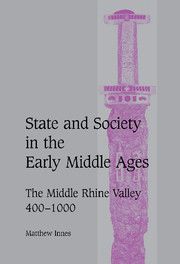Book contents
- Frontmatter
- Contents
- List of figures
- List of abbreviations
- A note on nomenclature and citations
- Acknowledgements
- Map 1 The Carolingian Rhineland
- Map 2 The Carolingian middle Rhine valley
- 1 INTRODUCTION
- 2 MONASTICISM, SPIRITUAL PATRONAGE AND SOCIAL STRUCTURE
- 3 LAND, KINSHIP AND STATUS
- 4 LOCAL POWER: COLLECTIVE ACTION, CONFLICT AND CONSENSUS
- 5 LOCALITY AND CENTRE: MECHANISMS OF EXTRACTION
- 6 POLITICAL POWER FROM THE FIFTH TO THE ELEVENTH CENTURY
- 7 CONCLUSION: STATE AND SOCIETY IN THE EARLY MEDIEVAL WEST
- List of primary sources
- Bibliography of secondary works
- Index
- Cambridge Studies in Medieval Life and Thought Fourth series
4 - LOCAL POWER: COLLECTIVE ACTION, CONFLICT AND CONSENSUS
Published online by Cambridge University Press: 10 July 2009
- Frontmatter
- Contents
- List of figures
- List of abbreviations
- A note on nomenclature and citations
- Acknowledgements
- Map 1 The Carolingian Rhineland
- Map 2 The Carolingian middle Rhine valley
- 1 INTRODUCTION
- 2 MONASTICISM, SPIRITUAL PATRONAGE AND SOCIAL STRUCTURE
- 3 LAND, KINSHIP AND STATUS
- 4 LOCAL POWER: COLLECTIVE ACTION, CONFLICT AND CONSENSUS
- 5 LOCALITY AND CENTRE: MECHANISMS OF EXTRACTION
- 6 POLITICAL POWER FROM THE FIFTH TO THE ELEVENTH CENTURY
- 7 CONCLUSION: STATE AND SOCIETY IN THE EARLY MEDIEVAL WEST
- List of primary sources
- Bibliography of secondary works
- Index
- Cambridge Studies in Medieval Life and Thought Fourth series
Summary
PATTERNS OF PUBLIC ACTION
The charter evidence allows us to investigate the relationships between those who exercised political power and the localities they ruled. The transactions recorded in the charters involved not only the transfer of rights over land, but also the definition of relationships between people. In that charters also list a supporting cast of those who witnessed and guaranteed the legitimacy of the transactions they record, they illuminate power relations between the principal actors and the supporting cast. They also supply information about stages and performances: they tell us where and when the public meetings were held, and supply identities for those who presided over, and recorded, these performances. That is, in the charters we can clearly see structured patterns of collective action. In what follows, we will first investigate the stages on which transactions took place, and the relationship between public meetings and the physical and social structure of rural and urban settlement. We will then move on to look at the legal traditions which informed the conduct of these meetings, in particular focusing on the scribes to whom we owe our surviving written records. Next, we will plot the activities of those who sought to rule the localities, uncovering the basis of their power. Finally, we will analyse the relationship between local structures of public action and the initiatives of kings and aristocrats, particularly in the crucial areas of law and violence.
Charter scribes chose to present the transactions they recorded as public actions.
- Type
- Chapter
- Information
- State and Society in the Early Middle AgesThe Middle Rhine Valley, 400–1000, pp. 94 - 140Publisher: Cambridge University PressPrint publication year: 2000

